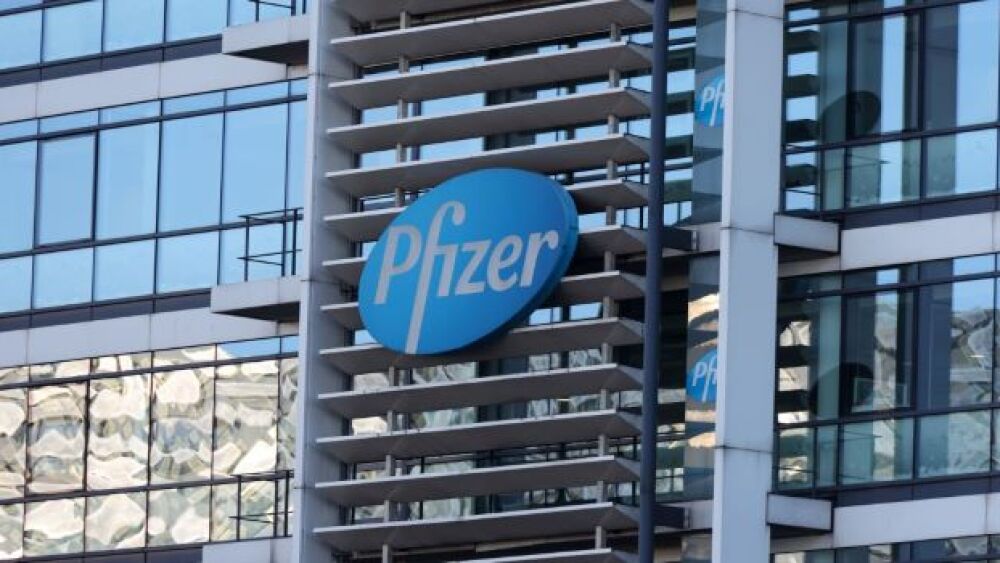The vaccine delivered more than $12 billion in revenue to Pfizer and the company expects those earnings to vastly increase this year to $32 billion.
Pierre Suu/Getty Images
Pfizer Chief Executive Officer Albert Bourla called 2021 a watershed year for the company. It posted $81.3 billion in revenue driven by sales of its COVID-19 vaccine, Comirnaty, co-developed with Germany’s BioNTech. The vaccine delivered more than $12 billion in revenue to Pfizer and the company expects those earnings to vastly increase this year to $32 billion.
As COVID-19 continues to run rampant across the globe in the third year of the pandemic, Pfizer anticipates continued significant revenue streams from Comirnaty, as well as Paxlovid, the oral antiviral medication that received Emergency Use Authorization from the U.S. Food and Drug Administration in December. In its guidance for 2022, Pfizer said it anticipates $32 billion of revenue for Comirnaty and an additional $22 billion from Paxlovid. In all, Pfizer predicts an estimated $98 billion to $102 billion for 2022.
During a conference call Tuesday morning, Bourla said that, in 2021, the company reached an estimated 1.4 billion people with its medicines and vaccines.
“That’s more than one out of every six people on Earth. Never before has Pfizer’s patient impact been so wide-reaching,” Bourla said. “While Comirnaty is having a significant positive impact on Pfizer’s financial performance, it’s the tremendous impact that COVID-19 vaccines have had on society that is most important. In the U.S. alone, the COVID-19 vaccination program is estimated to have saved more than one million lives and prevented more than ten million hospitalizations, according to a December 2021 Commonwealth Fund report.”
While the company’s COVID-19 drugs proved to be strong financial drivers. Pfizer noted in its year-end report that revenues only grew about 6% to $44.4 billion for the year. And in the fourth quarter of 2021, excluding the COVID-19 medications, sales dipped 2%.
Bourla noted that the ongoing pandemic would continue to play a role in the company’s financial bottom line. This is primarily due to the widespread belief that COVID-19 will shift from a pandemic to an endemic viral concern. Bourla said Pfizer had developed the tools, such as Comirnaty and Paxlovid, to help manage the pandemic and allow the world to return to a sense of normalcy that includes increased travel and social gatherings.
“At Pfizer, we are keenly aware of our responsibility to continue to invest in R&D to maintain our leadership in providing these tools and other meaningful solutions to the world. That’s why we continue to develop and test different versions of our vaccine to potentially address variants of concern as they emerge, and why we are currently working on a new omicron-based vaccine candidate and on a bivalent COVID-19 vaccine candidate,” Bourla continued. It’s also why just two months after receiving Emergency Use Authorization from the U.S. Food & Drug Administration for Paxlovid, we are already working on a potential next-generation oral COVID-19 treatment.”
Bourla predicted that the oral antiviral Paxlovid could be a game-changer for the virus. The company expects to produce six million treatment courses this quarter and more than 30 million treatment courses within the first six months of 2022. By the end of 2022, Bourla said Pfizer expects to quadruple the output of Paxlovid to 120 million courses of treatment.
Beyond COVID-19, Pfizer’s oncology products delivered more than $12 billion in revenue for 2021, a 13% increase over the $10 billion in sales for 2020. The inflammation and immunology business saw a decline of 3%. Sales fell from $4.5 billion in 2020 to $4.4 billion in 2021. The company’s rare disease sales increased nearly 20% from $2.9 billion in 2020 to $3.5 billion last year.
“In summary, 2021 was an outstanding year for Pfizer, and we look forward to continuing to apply the lessons learned from COVID to deliver breakthroughs for patients across all our therapeutic areas. We remain focused on being nimble, investing in our R&D organization and exploring dynamic partnerships that will enable us to fully realize the power of our science,” Bourla said.
Featured Jobs on BioSpace





